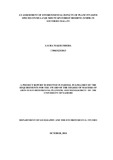| dc.description.abstract | n environmental impact assessment of woody plant invasive species was conducted on
Mulanje Mountain Forest Reserve in Malawi where plant invasive species are regarded as
the second largest threat to conservation of biodiversity after direct habitat destruction
(EAD, 2006). The main aim was to investigate the ecological and social impact of
plant
invasive species on Mulanje Mountain Forest Reserve (MMFR) in order to ascertain
means of addressing the possible effects on the communities in adjacent to
the reserve
and on
its ecology. Specifically, the study aimed at assessing the spatial distribution
and
ecological impacts of invasive species on MMFR,
evaluating the social impact
of
invasive species on adjacent communities and
identifying appropriate methods
for
managing
invasive species
and their impacts
on the reserve.
It was hypothesized that
invasive species have no significant ecological impacts on the biodiversity of Mulanje
Mountain Forest Reserve, that invasive species have no significant social impacts
on
the
communities adjacent to
the Reserve and that Current methods used in managing
impacts
of invasive species in Mulanje Mountain Forest Reserve are not effective.
In order
to meet the objectives, bot
h primary and secondary data were
used for the study.
A
semi-structured
questionnaire was used to collect primary data from the
household
respondents
to get their views on invasive species impact and their management from a
sample of 30 respondents who were systematically selected from the five villages
surrounding the reserve.
Questionnaires were also used to collect data from the key
inform
ants. The key informants that were interviewed included the Mulanje district Forest
Officer (D.F.O.), Mr. Jeffrey Juwawo, the technical officer for the Mulanje Mountain
Conservation Trust (MMCT)
, The Chairperson of the Village Forest Management
Committee (C
FMC) and these
were purposively selected based on their familiarity with
the reserve.
Data on ecological impacts were collected using a baseline
transect approach through the
Point Centred Quarter Method (PCQM) to measure
the
spatial distributionof invasive
species.
This involved
the use of three 1–1.2 km
long transects (eastern, middle and the
western transects)
while using the
PCQM
to assess distribution
of woody vegetation
along the three transects.
An interval of
50–
100 m
was estimated between
any two
consecutive observation points along depending on the variability
of vegetation cover
along the transects. Species diversity was calculated for each transects using the
Shannon-Weiner
method,
(Harris et al. 1983).
Data collected were
analysed
using Chi square and at 95% confidence level
after data had
been entered and stored in
SPSS computer package version 16.0
and Microsoft Office
Excel. Views
of respondents on invasive species, knowledge of the invasive species,
invasive species effect on beneficial plants and on the supply of other ecological goods
and services, species form was analysed using chi square test. Chi square test was used to
obtain levels of significance for the
non-parametric
data. Species use, source of invasive
Species, Species
abundance was assessed using descriptive statistics such as frequencies
and Cross Tabs. Crosstabs were used to summarize categorical data and creation of
contingency tables.
Following the analysis and discussion of the findings of this study,
presence of the
invasive species is much more significant on the western side of the reserve as the results
shows significant difference on the presence of the invasive species (p=0.003). The
identified invasive species include
pinus patula
and
Rubus ellipticus.In
vasive species
have proved to have both positive and negative impact on the livelihood of the
surrounding communities of the Re
serve as communities benefit from the invasive
species through the provision of the ecological goods and services
such as timber,
firewood and medicine and only 3 % of the respondents included that they are not useful
to them. On the other hand, invasive species have also affected the ecosystem by reducing
the population of useful species
the results have shown that invasive species
increase the
frequency of forest fires and this lead to biodiversity loss and threatened endangered
species by destroying their habitat and thus leading to their extinction. Ecologically,
invasive species have caused considerable loss of biodiversity on
the reserve through
prevention of regeneration of the native species that are endemic to the reserve. They
have also shown to be altering plant and animal habitat as well as disturbing the water
flow. The fact that invasive species benefit or please someone, their eradication may
impose costs to those in
benefit;
as a result, there may be some resistance in the control or
restriction on the use of the invasive species. Therefore management options should take
into consideration
of both costs as well as the
negative. It was therefore recommended
that reforestation programs should be implemented by planting trees with the same values
as those of the invasive species to replace then so as not to lose the benefits at the same
time maintaining the ecological integrity of the reserve | en_US |

